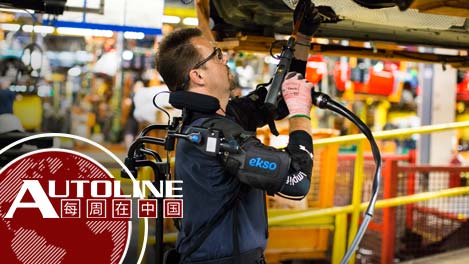
[autolinedaily show=”DailyChina013118″]
运行: 5:42
– 新型制动盘将大大减少粉尘
– 福特测试外骨骼技术
– 麦格纳的卡车主动空气动力学
– 雷诺自主汽车可避免高速时的障碍
– WAYMO的自动驾驶商业模式
请访问我们的赞助商,感谢他们的支持自动线的中国: Dow
大家好,我是约翰•麦克罗伊,欢迎收看Autoline 中国,我们的节目将为您呈现汽车领域最重要最前沿的行业新技术。
新型制动盘将大大减少粉尘
在汽车降低排放方面,最受关注的是如何改善发动机。但其实还有另外一个地方也会造成空气质量差。制动器和轮胎的排放占行驶相关颗粒排放的32%,而这其中一半是制动粉尘。这就是为什么博世开发了iDisc。与普通制动盘相比,它可以减少90%的制动粉尘。在用碳化钨涂层覆盖之前,制动盘的摩擦环经过机械处理、热处理和电镀处理。iDisc不仅使制动粉尘大大减少,同时它也具有与陶瓷制动器相似的性能,不会磨损太快或腐蚀,此外,其使用寿命可高达普通制动器的两倍。目前,iDisc比普通铸铁制动盘贵三倍,但比陶瓷制动器便宜三倍。一旦产量增加,价格很有可能会下降。欧洲一家不愿透露姓名的汽车制造商已在11月份开始使用iDisc。
福特测试外骨骼技术
装配工厂的生产线工人需要执行大量的重复性工作,并且随着时间的推移这会导致疲劳甚至受伤。 为了减少工人的体力损失,福特正在美国的两个工厂测试新的外骨骼技术。该设备称为EksoVest,它在工人执行头顶作业时支持工作人员的手臂。 身高在1.5到1.9米之间的工人可以穿着EksoVest背心,来帮助他们举起重达7公斤的工具或物品。 该公司计未来在其他地区测试EksoVest。
麦格纳的卡车主动空气动力学
随着燃油经济性标准的不断提高,汽车制造商们更加重视空气动力学,尤其是在皮卡车上。 供应商公司麦格纳正在开发主动气动功能。就像这些在高速公路上封闭前端的格栅百叶窗一样,一旦卡车达到每小时48公里,它也有一个配备在前保险杠下方的扰流板。然而这正是有趣之处。连接到尾门内侧的面板向上移动以将空气引导到尾门上方。 它实际上比货箱盖更具空气动力学。当空气流经皮卡车时,货厢捕捉空气泡沫,但它撞击到后挡板,导致拖拽。 货箱盖防止空气气泡形成,这也会造成阻力。 但是这个小小的挡板既能够保持气泡的位置,又能防止空气撞击到后挡板,从而改善空气动力性。
雷诺自主汽车可避免高速时的障碍
雷诺正在炫耀其可避开障碍的自动驾驶技术。虽然我们已经看到其他公司的自动驾驶汽车可在缓慢移动的环境中避开障碍,但正如您所看到的,雷诺的技术Callie能够在高速行驶时躲避障碍。该公司表示,其避障能力以达到专业测试驾驶员的水平。该技术是其与斯坦福大学合作开发的。到2022年,雷诺的目标是在道路上拥有超过15辆具有一定程度自主驾驶能力的车辆,而这个新系统将是实现此目标的重要一步。
WAYMO的自动驾驶商业模式
自从Google开始开发自动驾驶汽车技术以来,每个人都想知道它将如何进入市场?它会制造自己的汽车,还是其他什么?现在,John Krafcik能告诉我们更多。作为Waymo的负责人,John看到了四个商机。首先,他说他们将把自动驾驶系统授权给汽车制造商,他还提到菲亚特克莱斯勒在这方面是一个了不起的合作伙伴。其次,他说物流和货运公司非常感兴趣,因为Waymo可以把其系统放在8类半成品上。在那之后,各城市市政府希望将其运用到“最后一英里交通”上。但也许最重要的是,Waymo希望提供自己的乘车分享服务。所以Uber和Lyft可能要小心了,因为Waymo将紧随其后。
那今天的节目到这里就结束了。感谢您收看每日Autoline。
Hello, I’m John McElroy, welcome to Autoline China, the show that covers some of the most important new technologies in the automotive industry.
NEW BRAKE DISC GREATLY REDUCES DUST
When it comes to reducing emissions most of the focus is on improving the engine. But there’s another area of the car that contributes to poor air quality. Brakes and tires are responsible for 32% of driving related particulate emissions and half of that is brake dust. That’s why Bosch developed the iDisc. It generates up to 90% less brake dust compared to a conventional disc. The friction rings of the disc are mechanically, thermally and galvanically treated before being covered with a tungsten-carbide coating. Not only is brake dust greatly reduced, the iDisc has similar performance to a ceramic brake, doesn’t wear as fast or corrode and has up to twice the service life of a normal brake. Currently the iDisc is three times more expensive than a normal cast iron brake rotor but three times less expensive than a ceramic one. And the price will likely drop once production increases. An un-named European automaker started using the iDisc in November.
FORD TESTS EXOSKELETON TECHNOLOGY
A line worker at an assembly plant needs to perform a lot of repetitive tasks and over time that can lead to fatigue or even injury. So to reduce the physical toll on its workers, Ford is testing out new exoskeleton technology at two of its plants in the U.S. The device, called EksoVest, supports workers arms while performing overhead tasks. Workers between 1.5 and 1.9 meters tall can wear the vest, which helps them lift tools or objects up to 7 kilograms. The company plans to test the EksoVest in other regions in the future as well.
MAGNA’S ACTIVE AERODYNAMICS FOR TRUCKS
As fuel economy standards continue to become stricter, automakers are putting a heavier emphasis on aerodynamics, especially with pick-up trucks. The supplier company Magna is developing active-aerodynamic features, like these grille shutters that seal off the front end at highway speeds. It also has a spoiler that deploys from under the front bumper once a truck reaches about 48 kilometers per hour. But here’s where it gets more interesting. A panel that attaches to the inside of the tailgate moves up to direct air over the tailgate. It’s actually more
aerodynamic than a tonneau cover. When air flows over a pickup cab, the bed traps a bubble of air, but it smashes into the tailgate, causing drag. A tonneau cover prevents the bubble of air from forming, which also causes drag. But this little flap keeps the bubble in place, prevents air from smashing into the tailgate and that improves aerodynamics.
RENAULT AUTONOMOUS CAR CAN AVOID OBSTACLES AT HIGH SPEEDS
Renault is showing off autonomous technology that can avoid obstacles. While we’ve seen self-driving cars from other companies avoid obstacles in slower moving environments, as you can see, Renault’s technology, called Callie, is able to do it at higher speeds. The company says its obstacle avoidance capability is just as good as professional test drivers. The technology was developed in collaboration with Stanford University. By 2022, Renault aims to have more than 15 vehicles with some degree of autonomy out on the roads and this new system is an important step in that goal.
WAYMO’S AUTONOMOUS BUSINESS CASE
Ever since Google started developing autonomous car technology everyone wanted to know how it was going to go to market with it? Would it make its own cars, or what? Well, now we know more. John Krafcik, the head of what is now called Waymo sees four business opportunities. First, he says they will license their autonomous system to automakers, and he says FCA is an amazing partner in that effort. Next, he says logistics and trucking companies are very interested because Waymo can put its system on Class 8 semis. After that, cities and municipalities want it for what they call the last mile of transportation. But perhaps most importantly Waymo wants to offer its own ride sharing service. So watch out Uber and Lyft. Waymo is coming after your business.
And with that we wrap up today’s show, thanks for watching Autoline China.

John McElroy is an influential thought leader in the automotive industry. He is a journalist, lecturer, commentator and entrepreneur. He created “Autoline Daily,” the first industry webcast of industry news and analysis.





